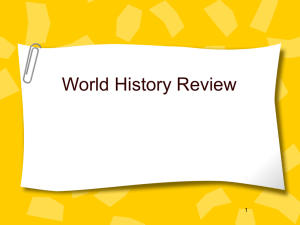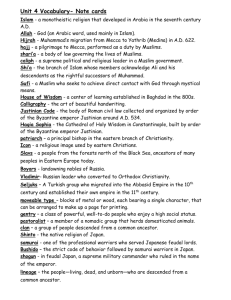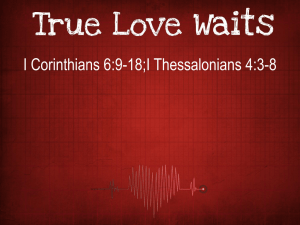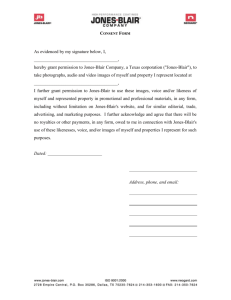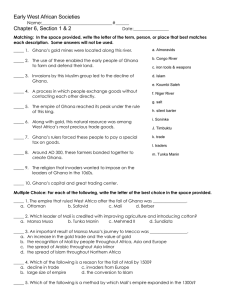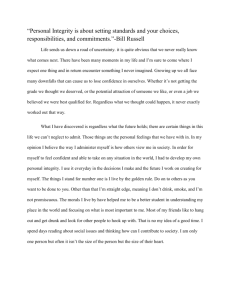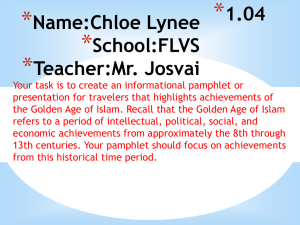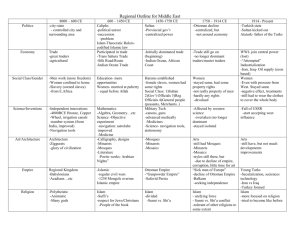5PhamCeline7thGradeCSTTaskListSelby
advertisement
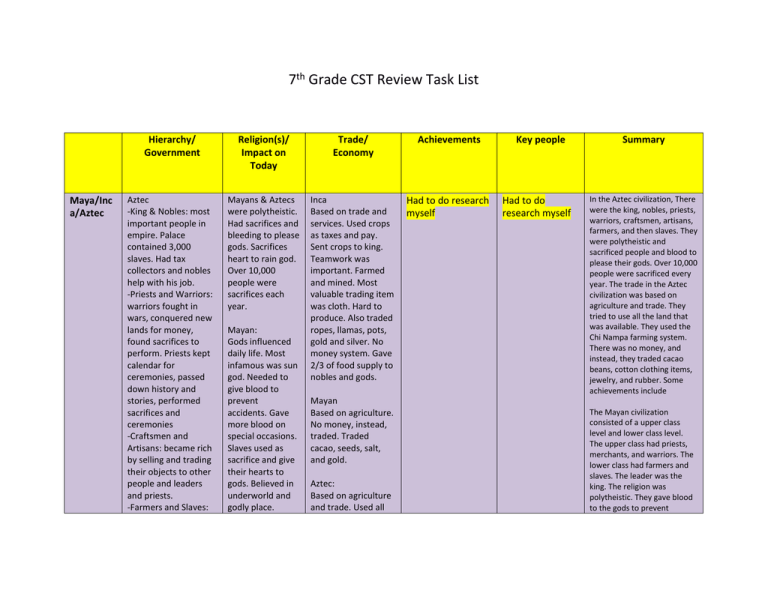
7th Grade CST Review Task List Maya/Inc a/Aztec Hierarchy/ Government Religion(s)/ Impact on Today Trade/ Economy Achievements Aztec -King & Nobles: most important people in empire. Palace contained 3,000 slaves. Had tax collectors and nobles help with his job. -Priests and Warriors: warriors fought in wars, conquered new lands for money, found sacrifices to perform. Priests kept calendar for ceremonies, passed down history and stories, performed sacrifices and ceremonies -Craftsmen and Artisans: became rich by selling and trading their objects to other people and leaders and priests. -Farmers and Slaves: Mayans & Aztecs were polytheistic. Had sacrifices and bleeding to please gods. Sacrifices heart to rain god. Over 10,000 people were sacrifices each year. Inca Based on trade and services. Used crops as taxes and pay. Sent crops to king. Teamwork was important. Farmed and mined. Most valuable trading item was cloth. Hard to produce. Also traded ropes, llamas, pots, gold and silver. No money system. Gave 2/3 of food supply to nobles and gods. Had to do research myself Mayan: Gods influenced daily life. Most infamous was sun god. Needed to give blood to prevent accidents. Gave more blood on special occasions. Slaves used as sacrifice and give their hearts to gods. Believed in underworld and godly place. Mayan Based on agriculture. No money, instead, traded. Traded cacao, seeds, salt, and gold. Aztec: Based on agriculture and trade. Used all Key people Had to do research myself Summary In the Aztec civilization, There were the king, nobles, priests, warriors, craftsmen, artisans, farmers, and then slaves. They were polytheistic and sacrificed people and blood to please their gods. Over 10,000 people were sacrificed every year. The trade in the Aztec civilization was based on agriculture and trade. They tried to use all the land that was available. They used the Chi Nampa farming system. There was no money, and instead, they traded cacao beans, cotton clothing items, jewelry, and rubber. Some achievements include The Mayan civilization consisted of a upper class level and lower class level. The upper class had priests, merchants, and warriors. The lower class had farmers and slaves. The leader was the king. The religion was polytheistic. They gave blood to the gods to prevent Most citizens were farmers. Lived in mud and stick houses. Paid rough taxes. Prime contestant for sacrifices Maya -Higher class: priests (led and helped in religious ceremonies. Used math and astrology). Merchants (directed trade and supplies between cities). Warriors (wore elaborate clothing to battle) -Lower class: farmers (served in army and gave crops to government. Worked on temples and construction projects) -Leader: lead religious ceremonies, military, and wore fancy clothes from gold. Considered a god. Inca -Higher: run empire. Owned servants. Had no taxes. Higher class women had duties on other women. -Lower: no slaves. Most were farmers Everyone had animal companion. Kings had jaguars. Inca: Never forces conquered people to worship their religion. Have ceremonies for sun god. Try to tie the sun down to keep it from disappearing in winter. Kings related to sun god, so they can’t die. land available. Used Chi Nampa farming system. No money. Traded cacao beans (most important item), cotton, clothing items (from feather, and jaguar skins), jewelry and rubber. accidents from happening. They gave even more blood for special occasion and ceremonies as well. They had slaves be sacrificed and give their hearts to the sun god. They also believed in an underworld and godly place. The Mayan economy was based on agriculture. There wasn’t any money; so instead, they traded cacao, seeds, salt, and gold. The Incan civilization had upper and lower classes. The upper ran the empire, owned servants and had no taxes. The upper class women even had duties on other women. The lower class didn’t have slaves. Most of them were farmers and artisans. They had to be in the army, pay taxes, and were selfeducated. Some achievements include hieroglyphics, ball courts, floating gardens, judges and written laws, and freeze dried foods. Some important people include K'inich Yax K'uk' Mo', the first leader of the Mayan civilization. Montezuma II was the second ruler of the Aztec civilization and was highly respected and powerful. He helped increase the Aztec’s wealth. Manco Cápac is believed to be the founder of the Incan civilization. and artisans. In army, paid taxes, wore plains clothes, selfeducated. China in the Middle Ages Medieval Japan Had to do research myself Shinto and Buddhism. Buddhism believed in after life. Most temples built by priests. World’s largest Buddha statue located in Todaiji temple. Teaches peace, selfcontrol, and lead a better life by meditating. Had Pure land Buddhism (believed in Amida, Buddha of love and mercy) Had to do research myself -Women were taught to write in Japanese -science, art, and literature Had to do research myself In Medieval Japan, the Emperor and Shogun were at the top of the feudal system. The Shogun really had all the power while the Emperor was like a puppet figure. The Daimyo were powerful warlords under the Shogun. The Samurai fought in the Daimyo’s army. The Peasants consisted of farmers, craftsmen, artisans, and merchants. The two main religions at the time were Shinto and Buddhism. Buddhism believed in afterlife. Most temples were built by priests. Buddhism focused on peace, selfcontrol, and leading a better life. They traded pottery, armor, weapons, cloth, carvings, daggers, jade, combs, household items, and clay figures. People had taxes and they were collected more efficiently than before. Many achievements in ancient japan were in science, art, and literature. Also, women were finally taught to write in Japanese, but not Chinese like the men. Some key people include Queen Himiko, who Fall of Rome Had to do research myself Polytheistic, much like Greeks. Greeks highly influenced Romans, even though enemies. Believed that Greek and Roman god and goddesses were the same. Different names and harsher personalities. Had to do research myself Military, aqueducts (took water to crops and bathhouses, roads (allowed people and carts to get to places), the dome (used on churches, theaters, and coliseums), arching bridges, bathhouses, theaters, and cities. System of morals called 12 tablets (engraved in 12 plates of bronze) -Diocletian: Roman emperor who divided Roman Empire into eastern and western halves. -Constantine: Roman emperor who was first to become a Christian. Moved capital from Rome to Constantinople and removed bans on Christianity. -Clovis: King of the Franks. Christian leader who was one of the most powerful rulers of Germanic barbarians. -Attila: Leader of the Huns. Led invasions of Constantinople, Greece, Gaul, and northern Italy. Greatly feared by Romans. -Augustus: first emperor of Rome The Fall of Rome had Emperor, the royal class, the upper class and patrician, middle class, lower class, and then slaves. The main religion in Rome was polytheistic and was similar to the Greeks’. Greek culture highly influenced Romans, even though they were enemies. It is believed that the Greek and Roman gods and goddesses were the same, but had different names and harsher personalities. People in Rome grew wheat, barley, olives, grapes, apples, onions, and celery. Sold grown products in markets. Farmers paid taxes in money and crops. Rich people rented out land to poorer farmers. Slaves farmed on rich’s land. Traders traded internationally. Bought papyrus, glass, pork sausage, salt, tin, fish sauce, cooking pots, dishes, and olive oil from across Mediterranean. Some achievements include aqueducts (to transport water), roads (for traveling ease), domes (used on churches, theatres, and coliseums), arching bridges, and theaters. Some key people include Diocletian, an emperor of Rome who split the empire into 4 parts and assigned leaders to rule over each part. Constantine was a Ghana/M ali Had to do research myself Islams and Christianity. Ghanaian had freedom to choose religion. Empire ended up splitting into two (Islam vs. NonIslam). Religion in Mali was Islam. Spread of Islam blended with traditional and local practices (mixing phase). Mansa Musa preached Islam faith on journey to and from Mecca. Had to do research myself Ghana: -People came from different places. Rulers decided to force taxes on new people coming. Traders had taxes on goods they carried goods they took with them when they left. -powerful army helped conquer many neighbors (centers of trade). Made kings richer. Advanced trade Mali: Sundiata had new farmlands cleared for beans, onions, rice, and other crops, and cotton (new crop). Used cotton to make clothing. Sold cotton to other people. -Almoravids: a group that attacked Ghana in 1060s. attacked to make leaders convert to Islam -Tunka Manin: helped Empire of Ghana reach its peak. King of empire. Had great court system. Kingdom was visited by Muslim writers. -Sundiata Keita: founder of Empire of Mali. Hero of Mandinka people of West Africa -Mansa Musa: tenth Mansa. Means “King of Kings” or “Emperor” from Mailan Empire. Mali reached Roman Emperor who moved that capital to Constantinople. He also made Christianity a popular religion. Theodosius divided the Roman Empire into two parts known as Roman and Byzantine. Odoacer was a Germanic leader who seized Rome and overthrew Augustus and ended Western Roman Empire. In the Ghana civilization, there was the king, his council of elders, district leaders, artists, farmers, and miners. Most of the population was made up of farmers and miners. The two main religions in Ghana were Islam and Christianity. Their civilians actually had the freedom to choose their own religion. Later on, the empire split in two (Islam vs. Non-Islam). The religion in Mali was Islam. The Spread of Islam blended with the traditional and local practices, known as the mixing phase. The economy was very good in Ghana. They controlled the trade routes between the salt and gold mines. The army would keep the traders safe and got gold nuggets in return, making the people of Ghana rich. Some achievements in Ghana include the rulers’ tax on foreigners coming into the empire to trade. Another was Ghana’s powerful army that height of wealth, power and fame in 1300s -Maghan (Son of Mansa Musa): took over throne after dad died. Weak leader who ended up causing trouble for Mal. Rise of Islam Had to do research myself Had to do research myself One of fastest growing religions in the world. Monotheistic religion that developed in Middle East in 7th century. Like a church school. Founded by Prophet Muhammad. Means “surrender” and “submission”. Two divisions (Sunni and -Medicine; one of the best to heal wounded people -Scholars: Islamic schools were one of best for their religion. -Paper mail: used mail route around whole city (sometimes took a whole day) -Art: very detailed Muhammad: Prophet who spread word of god and helped turns Mecca Islamic. -Fatimah: Muhammad’s daughter. Married his cousin Ali. Sons began Fatimid Dynasty. Ali was origin of split between Sunni and helped conquer man neighbors. They were also the center of trade and very advanced in it. In Mali, Sundiata had new farmlands cleared for beans, onions, rice, cotton, and other crops. They used the cotton to make clothing and to sell them. some important people include Almoravids, a group that attacked Ghana and made the leaders convert to Islam. Tunka Manin was a king who helped the Empire of Ghana reach its peak by having a great court system. Sundiata Keita was the founder of the Empire of Mali. Mansa Musa was a king of the Malian Empire and helped the Empire reach the height of its wealth, power, and fame in the 1300s. Maghan was the son of Mansa Musa and caused trouble for the Empire of Mali because he was a weak leader. During the Rise of Islam,… The Rise of Islam affects us today because Islam is now the most popular religion in the world. It is also the fastest growing religion. Islam teaches to follow the Qur’an, live a good life, and treating other people fairly. Islam has two divisions known as Sunni and Shi’a. One achievement was in medicine because they would be the best to heal wounded people. Another Medieval Europe Had to do research myself Had to do research myself Shi’a). Had five pillars (guidelines) and abraded by old and young citizens -Literature: information that they HAD to teach for days Shia. -Abu Bakr: Islamic leader after Muhammad’s death. First caliph (highest position in Islam). Made Arabia and unified Muslim state. -Mehmed II: military leader of Ottomans. Used cannons to capture Constantinople. Turned Hagia Sophia (church) into a mosque. Akbar: emperor of Mughals (Turkish Muslims from Cen. Asia). Began tolerant religion policy. Got rid of taxes on other religions. Invited Hinduism to empire. Helped unify empire. Had to do research myself -Justinian’s code: code that helped all the laws by refreshing old ones -Marco Polo: merchant traveler. Traveled to Central Asia and China. achievement was that Islamic schools were one of the best for their religion. Also, paper mail was used on a mail route around the whole city. Islamic art was very detailed and abraded by old and young citizens. Islamic people were also very advanced in literature as well. Some important people include Muhammad, a prophet who spread the word of God and helped turn the city of Mecca Islamic. Fatimah was Muhammad’s daughter and married her cousin Ali. Her sons started the Fatimid Dynasty. Ali was the cause of the split in Islam. Abu Bakr was an Islamic leader after Muhammad’s death and the first caliph, the highest position in Islam. He also made Arabia a unified Muslim state. Mehmed II was a military leader of the Ottomans and used cannons to capture Constantinople. He also turned Hagia Sophia into a mosque. Akbar was an emperor of the Mughals who began a tolerant religion policy that embraced other religions instead of taxing them like before. He also helped unify the empire. In Medieval Europe, there was the king, bishops, barons, lords and peasants. The main religion at the time was Christianity. Everyone’s life and adding new ones. -agricultural advancement: had many tools. (i.e. horse drawn plow) -guilds: protected people from misfortune. -Buildings: cathedrals, castles, RomanesqueMedieval-Gothic architecture. Extremely hard to build (advanced) -trade: advanced. Spices, silk, soaps, rugs and other stuff. Wrote about things to show Europeans about Central Asia and China. Man of discovery. -William Tell: folk hero (popular in books) -Thomas Becket: Archbishop of Canterbury. Believed in “rights and privileges of Church”. Stood up for what he believed in (and was murdered) -Jack Cade: leader of Jack Cade Rebellion. Wasn’t happy about King Henry VI’s weak rule. Kicked out king. Captured London. -Dante Alighieri: Italian poet of Divine Comedy. “the greatest literary work composed in the Italian language and masterpiece of literature” was dominated by the Church. Everything people did was for religion or based on religion. The economy during the time Germanic tribes were invading Europe was poor because they took most their food, money, and shelter. Trading was difficult and education decreased. Life for everyone became harder and harsher. This was the cause of the Dark Ages. However, some achievements include Justinian’s code, which helped all the laws by refreshing the old ones and adding new ones. They also made agricultural advancements by creating many tools like a horse drawn plow. Guilds protected people from misfortune. Some buildings like cathedrals and castles were very advances and extremely hard to build. When trade was prosperous, people would trade spices, silk, soaps, rugs, and other stuff. Some important people include Marco Polo, a merchant traveler who went to Central Asian and China and recorded things he saw there. William Tell was a folk hero and was popular in books. Thomas Becket was an archbishop who stood up for his beliefs about the “rights and privileges of the Church” and was murdered for it. Jack Cade was the leader of the Renaissan ce -King: governed his entire kingdom. Tried to get as much land and money for kingdom. -Royal Advisors: advised king, and got lots of money for helping king -Land Owners: owned a lot of land -Merchants: sold products and worked mainly for money. Most were rich -Farmers: made and grew everyone’s food -Peasants: largest group (most of population) Most people were Catholic. Led up to modern Christian/Catholic religion. Inspired most of man’s greatest achievements. Rulers learned to tax people. Relied on trade. Rivers affected trade. Used rivers to send goods back and forth. Danube, Rhone, and Rhine rivers became great trade routes. Family fortunes were made in Florence in banking and industry. -Mona Lisa: famous painting by Leonardo da Vinci -Sistine Chapel: famous chapel designed by Michelangelo -Theatrical plays: like “Romeo and Juliet” and “Macbeth” -Medicine: first woman’s body was dissected. Learned more about female body. -Morgante: famous poem by Luigi Pulci. Was an epic poem. -Leonardo Da Vinci: famous artist/inventor. Created Mona Lisa and Last Supper. Created helicopter, submarine, conveyor belt, and glider. -Michelangelo Buonarotti: famous painter. Painted ceiling of Sistine Chapel. Sculpted Statue of David and Sculpture of Pieta. -William Shakespeare: from England. Wrote Macbeth, Romeo and Juliet, and A Mid Summers Night. -Johann Gutenberg: invented printing press. -Baldassare Jack Cade rebellion. He wasn’t happy about King Henry VI’s weak rule, so kicked out the king and captured London. Dante Alighieri was an Italian poet of Divine Comedy, known as “the greatest literary work composed in the Italian language and masterpiece of literature”. In the Renaissance, a king governed his kingdom, his advisors helped him make decisions, land owners owned land, merchants sold and traded products for money, farmers grew everyone’s food, and peasants were the largest group of people. The most popular religion was Catholicism. It led up to modern Christianity and Catholicism and inspired many great achievements. The Renaissance was the time when rulers learned to tax people. The economy relied on trade, which was helped by rivers. They used the Danube, Rhone, and Rhine rivers to transport goods. Some achievements include the famous painting by Leonardo Da Vinci, Mona Lisa, The Sistine Chapel that was designed by Michelangelo, theatrical plays like “Romeo and Juliet” and “Macbeth” written by William Shakespeare and “Morgante” a famous poem by Luigi Pulci. They also made Castiglione: Renaissance writer. Wrote : The Book of Courtier” (about ideal man and woman) Reformati on Had to do research myself People started to switch from Catholicism to Protestantism. Focused on reading bible. Held sermons on Sundays. Declared by Henry VIII. Queen Mary brought back Roman Catholicism and became the State’s official religion. Had to do research myself -Selling of Righteousness: method: -Martin Luther: changed way people thought. Convinced people that paying their way to heaven were wrong. -Lutheran Church: Martin Luther founded it. -people realized that to get to heaven, they had to be more faithful and live better lifestyles. Had to do research myself advancements in medicine, by dissecting the first female body. Some important people include Leonardo Da Vinci, a famous artist and invetor, Michelangelo, a famous painter, William Shakespeare, known for his plays and dramas, Johann Gutenburg, the inventor of the printing press, and Baldassare Castiglione, the author of the book, The Book of Courtier. During the time of the Reformation people started to switch from Catholicism to Protestantism, which focused on reading the Bible and holding sermons on Sundays. Protestantism was declared by Henry VII. Later on, Queen Mary brought back Roman Catholicism and it became the State’s official religion again… Some achievements include the Selling of Righteousness method. Another one is when Martin Luther changed the way people thought and convincing them that paying their way to heaven was wrong. The Lutheran Church was founded by Martin Luther when he created another branch of Christianity that fit his idea of an ideal way to live. The last achievement was when people realized that, in order to get to heaven, they needed to be more faithful and live better lifestyles. Some important people Scientific Revolutio n Newton believed everyone followed same laws (everyone was equal). Scientists believed they could improve society and change government. People discovered laws governed nature, and can govern humans, too. Revolution challenged power of Church. Religion, superstition, and fear were replaced by reason and knowledge. Many new ideas contradicted precious ideas by church. Traded between Europe, Africa, and Americas. Europe to Africa- cotton, weapons, liquor. Africa to Americasslaves. Americas to Europe- cotton, tobacco, sugar, and molasses. Coins had fixed value for first time. Encouraged international trade and banking. Jointstock owners made $ by selling stocks. -Idea that Earth was not the center of universe (by Copernicus) -Scientific Method: step by step procedures to perform experiments -Discovery of North America (by Columbus) -Telescope: allowed Galileo to make discoveries in space -Barometer: measured air pressure -Nicolas Copernicus: first to propose that Earth was not center of universe. -Johannes Kepler: founder of celestial mechanics and first to explain planetary motion. -Galileo Gelilei: invented the telescope. Disproved that Earth was center of universe -Rene Descartes: first to describe world in terms of matter and motion include Theodore Beza, a lawyer who helped translate and give his own versions of the Greek and Latin New Testaments. John Calvin was a lawyer who wrote the Institutes of the Christian Religion. Martin Luther disagreed with the Church’s system of “paying their way to heaven”. He was the founder of the Lutheran Church and his teachings started the Reformation. William Tyndale took advantage of the printing press and printed the New Testament in English. His commentaries on his Bible translations had him burnt at the stake by King Henry VIII. The Scientific Revolution was a time when the new ideas challenged the powers of the Church. They learned that if nature has laws that govern them, so should humans. The new scientific ideas contradicted the ideas of the Church. At the time, Europe, Africa, and the Americas traded cotton, weapons, liquor, tobacco, sugar, molasses, and even slaves between each other. They also made joint stocks. Some important achievements include the idea that Earth wasn’t the center of the universe, which was proposed by Copernicus. The Scientific Method was a step by stop procedure to perform -Isaac Newton: proposed universal gravitation and laws of motion. Age of Exploratio n Had to do research myself Had to do research myself Had to do research myself Had to do research myself Had to do research myself experiments. The discovery of North America was another one, which was discovered by Columbus. The telescope allowed Galileo to make new discoveries about space. The barometer measured air pressure. Some important people include Nicolas Copernicus, who was the first to propose that Earth wasn’t the center of the universe. Johannes Kepler was the first to explain planetary motion. Galileo invented the telescope and disproved that Earth was the center of the universe. Rene Descartes was the first to describe the world in terms of motion and matter. Isaac Newton proposed universal gravitation and laws of motion. During the Age of Exploration, the traders and merchants were more powerful than the feudal landowners… The impact the Age of Exploration has on us today is that America was discovered thanks to Columbus. Without this discovery, we wouldn’t be living where we do today and our lives would have never been the same. During this age, European explorers exchanged plants, animals, and ideas between the Americas. This was known as the Columbian Exchange. They began growing new plants and crops in Europe as well as raising new animals in their farms. Some important achievements include the discovery of the Americas by Christopher Columbus in 1492. Another achievement was their advancements in technology. Sailor used astrolabes and compasses to help them travel to places far away. More advanced maps were made to avoid open sea and make more accurate routes to get to places. Caravels helped sailors have an easier time while traveling because the triangular sails helped them sail against the wind and rudders helped them steer easier. Some important people include Christopher Columbus, the first European to sail west searching for a water route to Asia. Vasco da Gama was the first European to sail around south Africa and reach India. Magelian led the first expedition to sail around the world. Ptolemy was an astronomer who states that the the sun and planets moved around the earth in circular paths called geocentric theory. Enlighten ment

